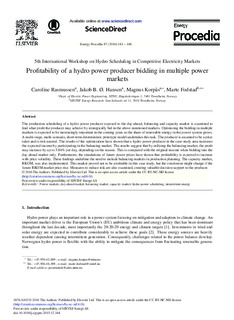Profitability of a Hydro Power Producer Bidding in Multiple Power Markets
Peer reviewed, Journal article
Permanent lenke
http://hdl.handle.net/11250/2378580Utgivelsesdato
2016Metadata
Vis full innførselSamlinger
- Institutt for elkraftteknikk [2498]
- Publikasjoner fra CRIStin - NTNU [38679]
Sammendrag
The production scheduling of a hydro power producer exposed to the day-ahead, balancing and capacity market is examined to find what profit the producer may achieve by strategically bid in the above mentioned markets. Optimizing the bidding in multiple markets is expected to be increasingly important in the coming years as the share of renewable energy in the power system grows. A multi-stage, multi-scenario, short-term deterministic prototype model undertakes this task. The producer is assumed to be a price taker and is risk neutral. The results of the optimization have shown that a hydro power producer in the case-study area increases the expected income by participating in the balancing market. The results suggest that by utilizing the balancing market, the profit may increase by up to 5.86% per day, depending on the season. This is compared with the original income when bidding into the day-ahead market only. Furthermore, the simulations of future power prices have shown that profitability is expected to increase with price volatility. These findings underline the need to include balancing markets in production planning. The capacity market, RKOM, was also implemented. This market proved not to be profitable in this case study, but the conclusion might change if the future RKOM market price rise. Measures to reduce risk are also examined, creating valuable decision support to the producer.
